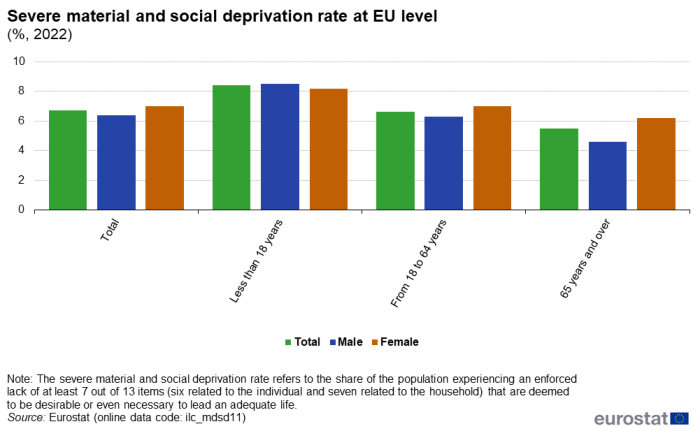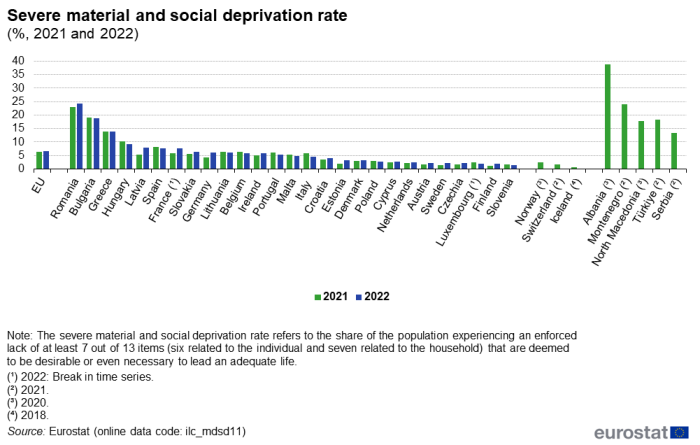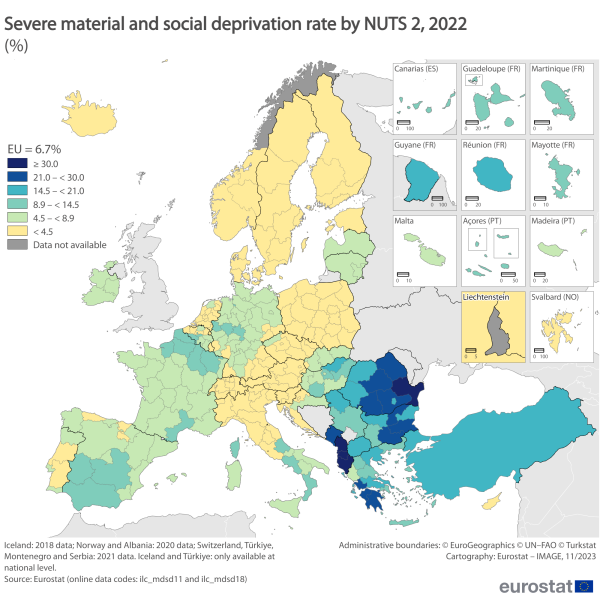Living conditions in Europe - material deprivation and economic strain
Data extracted in October 2023.
Planned article update: November 2024.
Highlights
In 2022, 6.7 % or 28.9 million of the EU population faced severe material and social deprivation.
In 2022, regional disparities in severe material and social deprivation rates were evident across the EU, with Romania's southeast exceeding 30 %, while all regions of Nordic Member States stayed below 4.5 %.
This article focuses on the severe material and social deprivation within the European Union (EU) in 2022. Values are presented at both country and regional NUTS level 2 as well as among different demographic groups.
All figures are based on EU statistics on income and living conditions (EU-SILC) available from Eurostat's online database. EU-SILC data are available for all EU Member States, as well as for most of the EFTA and candidate countries.
Full article
Key findings
In 2022, 6.7 % of the overall EU population experienced severe material and social deprivation. Severe material and social deprivation rates varied across EU Member States. Romania registered the highest rates at 24.3 %, followed by Bulgaria and Greece. By contrast, Luxembourg, Finland, and Slovenia reported the lowest rates, from 2 % downwards The overall EU rate of severe material and social deprivation slightly increased from 6.3 % in 2021 to 6.7 % in 2022. Specific demographic groups, notably those under 18, female, and single-adult households with dependent children reported high severe material and social deprivation values. Severe material and social deprivation varied across EU regions in 2022. Romania's south-eastern region had the highest rate, exceeding 30 %. Fifteen regions in Southern and Eastern Member States had rates between 21.0 % and 29.9 %, while all regions of Nordic Member States and others stayed below 4.5 %. Greece, Romania, and Bulgaria showed large regional disparities, with variations exceeding 15 percentage points (pp), compared with less than 2.0 pp in Finland, Ireland, Denmark, Slovenia and Lithuania.
Severe material and social deprivation
Material and social deprivation refers to the inability to afford a set of specific goods, services, or social activities that are considered by most people essential for an adequate quality of life. Individuals unable to afford five or more of the thirteen standard items experience material deprivation; those unable to afford seven or more are in severe deprivation (see the data sources section for a complete list of the thirteen items). This concept complements the relative analysis of monetary poverty by providing information on absolute poverty.
Female population more likely to experience severe material and social deprivation
In 2022, as shown in Figure 1, the EU experienced a slightly higher severe material and social deprivation rate among females (7.0 %) compared with males (6.4 %).
Looking at different age groups, those less than 18 years had the highest rate at 8.4 %, with females (8.2 %) experiencing a slightly lower rate than males (8.5 %). For individuals aged 18 to 64 years, the rate was 6.6 %, with females (7.0 %) having a higher rate than males (6.3 %). In the 65 years and over age group, the severe material and social deprivation rate was the lowest, at 5.5 %. Notably, males (4.6 %) within this age group had a lower rate than females (6.2 %).

(%)
Source: Eurostat (ilc_mdsd11)
Severe material and social deprivation in 2022 highest in Romania and lowest in Slovenia
In 2022, the rate of severe material and social deprivation in the EU Member States increased by 0.4 pp, rising from 6.3 % in 2021 to 6.7 %, as shown in Figure 2. The largest increases were observed in Latvia (up 2.5 pp), Estonia (up 1.4 pp) and Romania (up 1.2 pp). Decreases in the severe material and social deprivation rate were observed in Italy (1.4 pp), Hungary (1.1 pp), Portugal (0.7 pp) and Spain (0.6 pp).

(%)
Source: Eurostat (ilc_mdsd11)
South-Eastern EU regions reported the highest Severe material and social deprivation rates
Map 1 illustrates the occurrence of severe material and social deprivation rates at regional NUTS level 2 in 2022. Among all EU regions, Romania's south-eastern region recorded the highest regional share of severe material and social deprivation, with more than 30 % of the population facing such conditions.
Across the EU, nine regions had a share of people experiencing severe material and social deprivation ranging from 21.0 % to 29.9 %. These regions were in southern and eastern EU Member States, comprising four regions in Romania, three regions in Bulgaria, and two regions in Greece. Conversely, all regions in the EU Nordic Member States, and in Estonia, Poland, Austria, and Slovenia had a severe material and social deprivation rate below 4.5 %.
Greece, Romania, and Bulgaria showed significant inter-regional differences in severe material and social deprivation rates. The difference between the highest and lowest rates within these EU Member States were 19.3 pp, 17.7 pp and 15.8 pp, respectively. By contrast, inter-regional differences were less than 2.0 pp in Finland, Ireland, Denmark, Slovenia and Lithuania.

Source: Eurostat (ilc_mdsd11) and (ilc_mdsd18)
Source data for tables and graphs
Data sources
The data used in this article are primarily derived from EU-SILC. EU-SILC data are compiled annually and are the main source of statistics that measure income and living conditions in Europe; it is also the main source of information used to link different aspects relating to the quality of life of households and individuals.
The reference population for the information presented in this article is all private households and their current members residing in the territory of an EU Member State (or non-member country) at the time of data collection; persons living in collective households are generally excluded from the target population. The data for the EU are population-weighted averages of national data.
Context
Material and social deprivation indicators provide a measure related to the (in)ability of individuals to be able to afford a set of thirteen predefined material items that are considered by most people to be desirable or even necessary to experience an adequate quality of life. The list of thirteen items includes the following (seven related to the household and six related to the individual):
At household level:
- Capacity to face unexpected expenses
- Capacity to afford paying for one week annual holiday away from home
- Capacity to being confronted with payment arrears (on mortgage or rental payments, utility bills, hire purchase instalments or other loan payments)
- Capacity to afford a meal with meat, chicken, fish or vegetarian equivalent every second day
- Ability to keep home adequately
- Have access to a car/van for personal use
- Replacing worn-out furniture
At individual level:
- Having internet connection
- Replacing worn-out clothes by some new ones
- Having two pairs of properly fitting shoes (including a pair of all-weather shoes)
- Spending a small amount of money each week on him/herself
- Having regular leisure activities
- Getting together with friends/family for a drink/meal at least once a month
The material and social deprivation rate is defined as the proportion of the population that is unable to afford five or more out of this list of thirteen items.
The severe material and social deprivation rate is defined as the proportion of the population that is unable to afford seven or more of the above-mentioned items.
The severe material and social deprivation indicator (SMSD) is part of the at risk of poverty or social exclusion rate defined in the framework of the EU 2030 target on poverty and social exclusion.
The severe material and social deprivation indicator (SMSD) is part of the at risk of poverty or social exclusion rate (AROPE). The AROPE ratio is the share of the total population which is at risk of poverty or social exclusion. The headline target (EU2030 target) on poverty and social inclusion of the European Pillar of Social Rights Action Plan is to reduce the number of people at risk of poverty or social exclusion by at least 15 million by 2030. Progress towards this target is monitored through the AROPE rate, published by Eurostat.
Direct access to
- All articles from Living condtions
- Living conditions in Europe — poverty and social exclusion